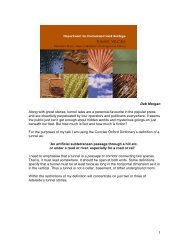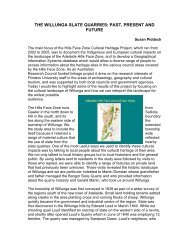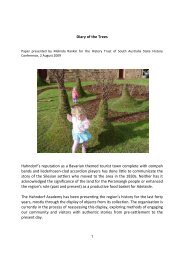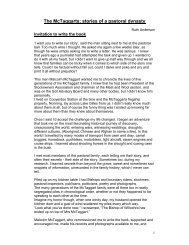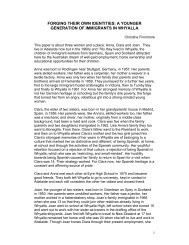Cornish Mining Heritage - History Trust of South Australia
Cornish Mining Heritage - History Trust of South Australia
Cornish Mining Heritage - History Trust of South Australia
You also want an ePaper? Increase the reach of your titles
YUMPU automatically turns print PDFs into web optimized ePapers that Google loves.
<strong>Cornish</strong> <strong>Mining</strong> <strong>Heritage</strong><br />
The significance <strong>of</strong> the <strong>Australia</strong>n <strong>Cornish</strong> <strong>Mining</strong><br />
<strong>Heritage</strong> Site – Burra and Moonta Mines<br />
Greg Drew<br />
Senior Geologist<br />
Mineral Resources Group<br />
Primary Industries and<br />
Resources SA<br />
Member<br />
<strong>Cornish</strong> <strong>Mining</strong> <strong>Heritage</strong><br />
Working Group
Justification for Inscription<br />
The Cornwall and West Devon <strong>Mining</strong> Landscape was inscribed on the<br />
World <strong>Heritage</strong> List under the following criteria.<br />
Criterion (a) (ii):<br />
Exhibit an important interchange <strong>of</strong> human values, over a span<br />
<strong>of</strong> time, or within a cultural area <strong>of</strong> the world, on developments<br />
in…technology…<br />
Criterion (a) (iii):<br />
Bear a unique, or at least exceptional, testimony to a cultural<br />
tradition…which is living or which has disappeared.<br />
Criterion (a) (iv):<br />
Be an outstanding example <strong>of</strong> a type <strong>of</strong> … technological ensemble<br />
or (and) landscape which illustrates (a) significant stage(s) in<br />
human history.
“World <strong>Heritage</strong> status recognises<br />
<strong>Cornish</strong> mining’s fundamental<br />
influence on World hard rock<br />
mining, ore dressing and in<br />
particular steam engine technology<br />
during the 19th century.<br />
During this time Cornwall<br />
developed a distinctive regional<br />
identity which took on global<br />
significance with mass migration <strong>of</strong><br />
<strong>Cornish</strong> culture after 1840.<br />
<strong>Cornish</strong> technology embodied in its<br />
engines, engine houses and<br />
mining equipment was exported<br />
around the world along with its<br />
mining culture”.
The significance <strong>of</strong> the <strong>Australia</strong>n <strong>Cornish</strong> <strong>Mining</strong><br />
<strong>Heritage</strong> Site – Burra and Moonta Mines (1845-1923)<br />
Criterion (a) (ii):<br />
Exhibit an important interchange <strong>of</strong> human values, over a span <strong>of</strong> time,<br />
or within a cultural area <strong>of</strong> the world, on developments in…technology…<br />
Technological advances<br />
• <strong>Cornish</strong> mining and ore dressing methods<br />
• The <strong>Cornish</strong> Beam Engine and enginehouse<br />
Criterion (a) (iii):<br />
Bear a unique, or at least exceptional, testimony to a cultural<br />
tradition…which is living or which has disappeared.<br />
<strong>Cornish</strong> people and cultural traditions<br />
• Mine management<br />
• Tribute and Tutwork employment systems<br />
• Survey or Setting Day<br />
• Sampling Day<br />
• Engine Opening Day
<strong>Cornish</strong> <strong>Mining</strong><br />
A <strong>Cornish</strong> mine, 1830<br />
• <strong>Mining</strong> in Cornwall dates back to c.1800BC.<br />
• The first underground mining began in the 16 th<br />
Century.<br />
• By 1750 copper mining began on a large scale and<br />
by 1800, Cornwall was the principal mining area <strong>of</strong><br />
the World.<br />
• This dominance continued until 1850, when<br />
<strong>Cornish</strong> mining was at its peak and from then<br />
declined until the great crash in 1866 and by 1880<br />
copper mining had virtually ceased.<br />
• For more than a century <strong>Cornish</strong> miners were<br />
regarded as the best hard rock miners in the world.
<strong>Cornish</strong> <strong>Mining</strong> Methods Criterion (aii)<br />
• <strong>Cornish</strong> mines worked tabular or<br />
rectangular mineral deposits known<br />
as veins or lodes.<br />
• Depending on the dip <strong>of</strong> the lode,<br />
a shaft was sunk vertically to<br />
intersect the lode or inclined<br />
following the lode.<br />
• At 10 fathoms depth (60ft or 18m)<br />
a horizontal level or drive was<br />
excavated in both directions and<br />
further shafts sunk at intervals <strong>of</strong><br />
50 fm for ventilation.<br />
• Further levels were driven at 10<br />
fm intervals thus dividing the mine<br />
into masses 50x10 fm.<br />
• These were further subdivided by<br />
internal shafts or winzes into<br />
masses 16-20x10 fm.
• These masses were then surveyed<br />
into blocks called pitches.<br />
• Opening up <strong>of</strong> the mine was called<br />
tutwork which prepared the lode for<br />
extraction <strong>of</strong> ore or tribute.<br />
• Hence two kinds <strong>of</strong> work were<br />
undertaken – development and ore<br />
extraction. These were carried out<br />
simultaneously allowing the concept<br />
<strong>of</strong> ore reserves (or eyes) to be<br />
established.<br />
• In raising ore, miners worked from<br />
the back or upper part <strong>of</strong> one level<br />
towards the bottom <strong>of</strong> another.<br />
• The resultant excavation or stope<br />
arranged for ore to fall to the level<br />
below and wheeled in trucks<br />
(tramming) to a hauling shaft.
Level Intervals<br />
1-11 10 fathoms<br />
12-16 15 fathoms<br />
17-29 20 fathoms<br />
Plan
Shot holes were drilled by hammer and tap method<br />
until the 1890s when replaced by drilling machines.
Hand drilling blast holes at Wallaroo Mines, c.1910
Overhand stoping at Wallaroo Mines, c.1915.
Loading from an ore stope in a well timbered drive, Wallaroo Mine c.1915
• The practical direction <strong>of</strong> all<br />
<strong>Cornish</strong> mines was undertaken by<br />
mine captains. These included<br />
underground captains and surface<br />
or grass captains. The principal<br />
captain was usually the mine<br />
manager.<br />
•Other salaried staff included the<br />
Purser (or accountant), Assayer,<br />
Pitman, Engineer and Doctor. All<br />
staff were provided with housing on<br />
the mine property.<br />
• At its peak, the Moonta Mine<br />
employed almost 1600 men and<br />
boys, including 18 captains and<br />
other <strong>of</strong>ficers.<br />
Mine Management Criterion (aiii)
• <strong>Cornish</strong> mines were worked by forms<br />
<strong>of</strong> contract employment called Tribute<br />
and Tutwork.<br />
• Tutwork involved the development <strong>of</strong><br />
the mine (dead work) by sinking <strong>of</strong><br />
shafts and driving <strong>of</strong> levels.<br />
• Tribute was used for extraction <strong>of</strong> ore<br />
and each party <strong>of</strong> miners or pare was<br />
paid a proportion <strong>of</strong> the value <strong>of</strong> ore.<br />
• The underground workings were<br />
surveyed into blocks or pitches.<br />
• Each pitch and tutwork contract or<br />
take was numbered and let by public<br />
auction on Survey or Setting Day for a<br />
period <strong>of</strong> two months.<br />
• Each pare was responsible for<br />
breaking and sorting ore, tramming to a<br />
shaft, and paying for hauling and ore<br />
dressing <strong>of</strong> ore, candles, tools and<br />
gunpowder.<br />
Tribute and Tutwork Criterion (aiii)<br />
Examples <strong>of</strong> tributors’ ore records, Burra Mine 1865
Longitudinal section along Hoggs Lode, Moonta Mine c.1880<br />
Enlargement showing<br />
tribute pitches
Survey or Setting Day Criterion (aiii)<br />
• Each contact or take lasted for two months<br />
after which another contract was let.<br />
• The day when miners were paid for the<br />
previous take and took new contacts was<br />
known as Survey or Setting day. This was a<br />
traditional holiday for <strong>Cornish</strong> miners.<br />
• The pares bid against each other for the<br />
various tribute pitches and tutwork contracts,<br />
the lowest bid being successful.<br />
• The bids were given as a value per £. eg. 1/6<br />
tribute would mean the pare would be paid 1/6<br />
for each £ <strong>of</strong> the total value <strong>of</strong> their ore.<br />
• The tribute was controlled by the richness <strong>of</strong><br />
the ore contained therein. If it were rich<br />
perhaps 4/- or 5/- tribute would pay the men<br />
fair wages, whereas if it were poor 10/- or more<br />
might be required.<br />
• At the next renewal <strong>of</strong> the pitch, the tribute<br />
rate was readjusted until the lode failed. A<br />
subsist was advanced to pares until the next<br />
survey day.
<strong>Cornish</strong> Ore Dressing Criterion (aii)<br />
• Ore from shafts was hand-picked at the<br />
surface into high grade (prills), low grade<br />
(drage or halvans) or waste (attle).<br />
• Prills reduced to walnut size and sent<br />
for smelting.<br />
• Drage reduced to sand size and sent to<br />
ore floors for concentration or dressing by<br />
jigging and buddling.<br />
• Up to the introduction <strong>of</strong> mechanised<br />
dressing machinery after 1860, ore<br />
dressing was very labour intensive<br />
employing large numbers <strong>of</strong> men and<br />
boys.<br />
• Women or bal maidens were also<br />
employed in dressing ore but this tradition<br />
was not implemented at Burra or Moonta<br />
<strong>Cornish</strong> ore dressing process, c.1850
Ore sorting floors<br />
Wallaroo Mine, 1890
<strong>Cornish</strong> crusherhouse,<br />
c.1860<br />
Richmans Crushing and Dressing<br />
Complex, Moonta Mine, 1890
<strong>Cornish</strong> Hand jigger<br />
Dressing floors, Sliding Rock Mine,1875
Burra Ore Dressing Floors, 1858
<strong>Cornish</strong> buddles, Moonta Mine, c.1890
• During a take, each pare’s<br />
concentrated ore was placed in a<br />
separate pile.<br />
• These piles were flat topped and<br />
up to 0.75m high with and 4m<br />
square.<br />
• At the end <strong>of</strong> a take each pile<br />
had to be sampled to determine<br />
the amount <strong>of</strong> copper as the<br />
miners were paid on that basis.<br />
• To ensure a representative<br />
sample, the tributors ensured that<br />
the pile was thoroughly mixed by<br />
re-turning and cutting.<br />
• The company sampler then<br />
bagged a small sample for assay.<br />
• A set <strong>of</strong> portable scales was<br />
then used to weigh the pile a<br />
hundredweight at a time.<br />
Sampling Day Criterion (aiii)<br />
Sampling Day, Burra Mine 1858. From a painting by Wm Bentley
Settling Up Criterion (aiii)<br />
• A weighed amount <strong>of</strong> each sample<br />
was dried and re-weighed to determine<br />
the water content.<br />
• This ore sample was taken to the mine<br />
Assay Office where the copper content<br />
was determined by fire assay.<br />
• This assay value and the net weight <strong>of</strong><br />
the tributors’ pile allowed the total<br />
amount <strong>of</strong> copper and hence its value to<br />
be calculated.<br />
• The assay value was critical as it<br />
determined the pare’s payment.<br />
• Many disputes arose concerning the<br />
value so an independent value was<br />
obtained for comparison.<br />
• Dissatisfaction with the company’s<br />
assays led to a four month strike at<br />
Burra in 1848.
<strong>Cornish</strong> Steam Technology Criterion (aii)<br />
From the early1700s, Cornwall<br />
played a leading role in the<br />
development <strong>of</strong> the stream engine<br />
used to pump water from its<br />
mines, haul ore to the surface and<br />
crush it.<br />
Newcomen engine, 1712<br />
Watt engine, 1769<br />
The first engine installed was a<br />
Newcomen engine in 1712. This<br />
was later modified by Boulton<br />
and Watt and first installed in<br />
Cornwall in 1777.
The <strong>Cornish</strong> Beam Engine<br />
• Steam power was the greatest technical<br />
innovation <strong>of</strong> the Industrial Revolution and<br />
Cornwall was central to its introduction and<br />
development.<br />
• After 1800, <strong>Cornish</strong> engineers began to<br />
develop the high pressure steam engine<br />
into what became known as the <strong>Cornish</strong><br />
Beam Engine.<br />
• This was further advanced by other<br />
<strong>Cornish</strong> engineers reaching its peak about<br />
1850. More than 2000 were erected in<br />
Cornwall <strong>of</strong> which about 200 survive.<br />
• <strong>Cornish</strong> engineering technology was<br />
exported to other mining areas from the<br />
mid 1820s including Mexico, S. <strong>Australia</strong>,<br />
Spain and S. Africa.<br />
• In SA, 23 <strong>Cornish</strong> engines were erected<br />
in the period 1848-1888 and the last to stop<br />
work was in 1923. All were made in<br />
<strong>Cornish</strong> foundries. In the 1860s and 1870s<br />
about 16 were working at one time in SA.
<strong>Cornish</strong> Engines in <strong>South</strong> <strong>Australia</strong><br />
(4)<br />
(10)<br />
(1)<br />
(2)<br />
(1)<br />
(1)<br />
(3)<br />
(8)<br />
(1)<br />
(1)
The <strong>Cornish</strong> Enginehouse<br />
The enginehouse supported the engine<br />
cylinder and beam and was part <strong>of</strong> the<br />
structure <strong>of</strong> the engine. There were four<br />
types <strong>of</strong> enginehouses.<br />
Balance<br />
weight<br />
Shears<br />
Front view<br />
Man Capstan<br />
Side view
Draft Enginehouse, Kapunda Mine, 1849<br />
30-inch beam rotative engine erected in 1848 –<br />
the first in <strong>Australia</strong>
Elders Enginehouse, Wallaroo Mines<br />
80-inch pumping engine erected in 1888 –<br />
the last in <strong>South</strong> <strong>Australia</strong>
Pitmen in front <strong>of</strong> Elders Enginehouse,<br />
Wallaroo Mine c.1900<br />
<strong>Cornish</strong> Pitmen<br />
Pitmen tending <strong>Cornish</strong><br />
pumping gear, Cornwall
<strong>Cornish</strong> Pitwork<br />
Burra Mine<br />
Clack piece<br />
Strapping plates<br />
Rising main<br />
Cistern
Beam pumping and winding enginehouses, Burra Mine<br />
<strong>Cornish</strong> Enginehouses<br />
Examples <strong>of</strong> all four variations<br />
<strong>of</strong> <strong>Cornish</strong> enginehouses<br />
survive in <strong>South</strong> <strong>Australia</strong><br />
In-house beam enginehouse, Worthing Mine, Hallett Cove Bull enginehouse, North Rhine Mine
<strong>Cornish</strong> <strong>Mining</strong> Landscapes Criterion (aiv)<br />
Moonta Mine, <strong>South</strong> <strong>Australia</strong> Great Flat Lode, Cornwall<br />
Real del Monte, Mexico Linares, Spain
• From the advent <strong>of</strong> steam<br />
technology it became a traditional<br />
<strong>Cornish</strong> custom that the starting<br />
day <strong>of</strong> a steam pumping engine<br />
was celebrated with much pomp<br />
and ceremony.<br />
• This custom continued in SA<br />
with most <strong>of</strong> the 15 <strong>Cornish</strong><br />
pumping engines erected<br />
between 1848 and 1888 having<br />
recorded Opening Days.<br />
• On starting <strong>of</strong> the engine, a<br />
bottle <strong>of</strong> wine was broken against<br />
the beam and christened with the<br />
name <strong>of</strong> mine owner, director or<br />
mine <strong>of</strong>ficial.<br />
• Then followed a day (and<br />
evening!) <strong>of</strong> festivities by<br />
directors and miners.<br />
Engine Opening Day Criterion (aiii)<br />
Schneiders Enginehouse, Burra Mine, 1858.<br />
Schneiders Engine was christened on 16 September 1852.
Bremer Mine, c.1865<br />
Leggs Pumping engine at left was<br />
christened in July 1859<br />
BREMER MINE, CALLINGTON - Amongst the various developments in progress in this<br />
colony, it affords as much satisfaction in recording the great event for the district <strong>of</strong> the<br />
successful working <strong>of</strong> a 60 inch cylinder steam-engine at this mine, on Friday, the 24th inst.,<br />
Midsummer-day (a day always observed by miners as a holiday in commemoration <strong>of</strong> the first<br />
coinage <strong>of</strong> tin in Cornwall). A large concourse <strong>of</strong> persons assembled from the mines in the<br />
district and the surrounding country to witness the interesting spectacle, the engine being the<br />
first <strong>of</strong> the kind erected in the district, and the second in size and power in the colony. About 5<br />
o'clock the engine was started, and worked much to the satisfaction <strong>of</strong> all concerned…..<br />
…..At 6 o'clock about 20 gentlemen sat down to an excellent dinner prepared by Mr. Lean,<br />
after which several toasts were drunk in honour <strong>of</strong> the mining and other interests. A<br />
substantial dinner was also given to the men belonging to the mine at the Tavistock Hotel,<br />
where all appeared to enjoy themselves, and every one expressed satisfaction with the<br />
proceedings <strong>of</strong> the day, the whole <strong>of</strong> which went <strong>of</strong>f with great eclat.<br />
Observer 2 July 1859
Conclusion<br />
<strong>Cornish</strong> <strong>Mining</strong> has been inscribed as a World <strong>Heritage</strong> Site<br />
for its outstanding Universal Value. It was noted by UNESCO<br />
that the story is incomplete without the international transfer <strong>of</strong><br />
<strong>Cornish</strong> mining technology and culture overseas.<br />
The <strong>Australia</strong>n <strong>Mining</strong> <strong>Heritage</strong> Site encompassing Burra and<br />
Moonta Mines State <strong>Heritage</strong> Areas is exceptional testimony.<br />
Burra Mine



